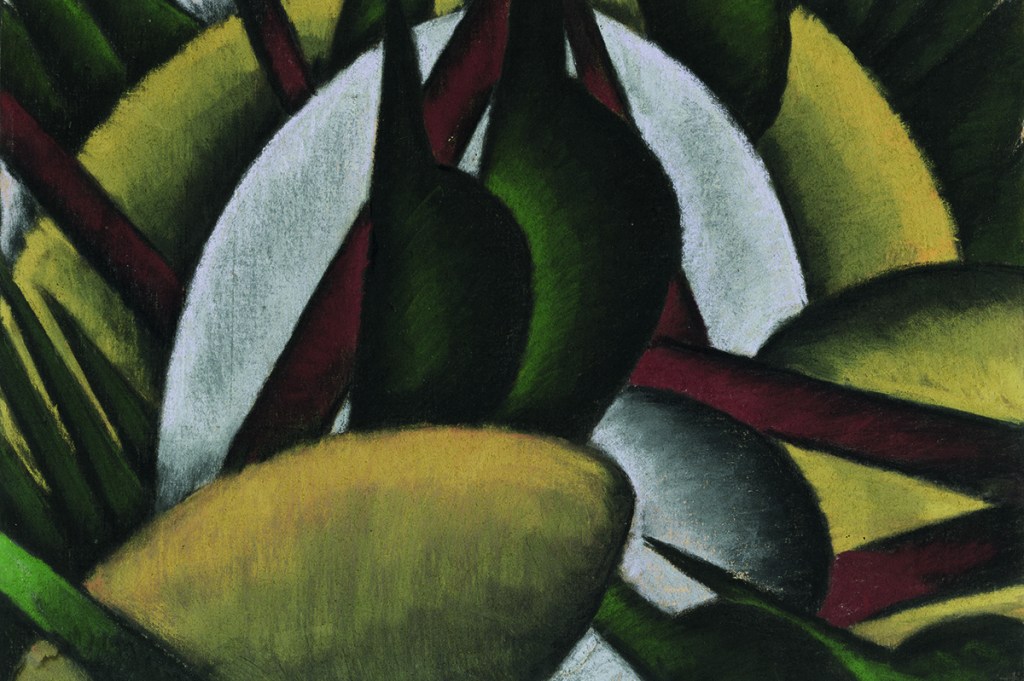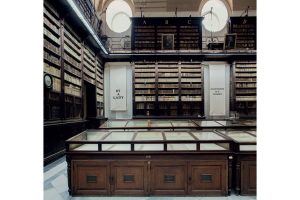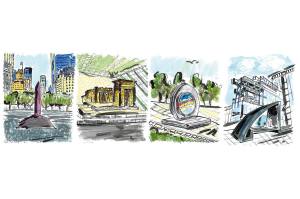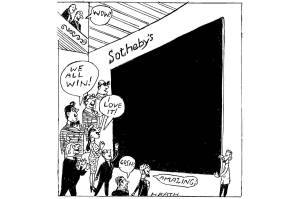What a difference a century makes. That’s the upshot of At the Dawn of a New Age: Early Twentieth-Century American Modernism, an exhibition at The Whitney Museum of American Art culled from its own holdings. In-house ventures can sometimes come off as so much house-cleaning, an opportunity to air out the storage racks and take stock of inventory. Which is, in fact, exactly what Whitney curator Barbara Haskell has done. But by adding select loans from other institutions and private collections, she’s put together a show that has its own Gestalt. Though the fervor of artistic innovation has a limited shelf life, the work on display here continues to radiate a klutzy, almost childlike audacity. There’s a naivete at the heart of At the Dawn of a New Age, and it is winning.
It may be relevant as well. Given the lead time for museum shows, Haskell had to know her overview of the stateside response to European Modernism would overlap with the latest iteration of the Whitney Biennial. The latter is, of course, the always anticipated (and invariably vilified) overview of American art that attempts to locate the pulse of the current art scene. The Biennial’s track record has been spotty; reading the tea leaves of contemporary culture always is. Still, you have to wonder: how many of the artists in the 2022 Biennial will make the cut of the 2122 model of At the Dawn of a New Age?
The vagaries of history are, of course, substantial. Both the production and consumption of art are radically different now from what they were in 1913 — that would be the year of the groundbreaking Armory Show in New York City, the event that introduced Americans to modern painting and sculpture. The dribs and drabs by which the innovations of Post-Impressionism, Fauvism, Expressionism and Cubism reached audiences back in the day seem a veritable trickle from our vantage point. Artists out to create a distinctively twentieth-century vision were primed for change but often halting on the uptake. Still, who’s to say that knowledge slowly accumulated isn’t more deeply absorbed than that gathered from a world in which (to paraphrase the title of a recent film) everything everywhere happens all at once?
As with most cultural endeavors of a recent vintage, At the Dawn of a New Age seeks to expand the canon by featuring work by artists who have been overlooked and undervalued. Haskell has located more than a handful of figures whose inclusion will warm the cockles of a social justice warrior’s heart. But there are other matters of redress afoot. When Gertrude Vanderbilt Whitney established the museum in 1930, the overriding emphasis was on realism. Though more outré strains of art were acknowledged, they weren’t necessarily embraced. Haskell notes that it wasn’t until the mid-1970s that the Whitney began to backtrack and acquire non-representational art that its founders had failed to appreciate.
At the Dawn of a New Age sets out to highlight “the capacity of abstraction to reflect individual responses to the… groundbreaking spirit of the age.” Haskell places a premium on a cultural optimism she attributes to progressive political campaigns and, especially, advances in technology: “nowhere else were cities so illuminated, manufacturing processes so efficient, or new forms of communication and transportation so pervasive.” Though the promises of the machine age had been tested by the carnage of World War One, artists continued to take inspiration from the streamlined forms and regulated rhythms found in industry. You can see them at play in Stuart Davis’s “Egg Beater No.1” (1927), as well as in the rigorously applied geometries and lustrous patina of “Painting” (c.1921-22), a still life by Patrick Henry Bruce.
The hiccup is that Davis and Bruce are pretty much the only artists who fit comfortably within Haskell’s thesis. If anything, the true basis of the art featured in At the Dawn of a New Age runs contrary to the machine-tooled advances of modern life. It’s not technology that’s the impetus, it’s the natural world. In piece after piece, we see the human form or, as is more often the case, the landscape serve as an armature on which matters of pictorial or sculptural form are explored.
Spiritualism, as well — nature having long served as a well-spring for those with otherworldly longings. At the entry to the exhibition, viewers encounter four paintings that are blatantly mystical in character. In them, Marsden Hartley toys with the astrological, Agnes Pelton immerses herself within a realm of fairies, Oscar Bluemner locates the Big Bang in New Jersey and Georgia O’Keeffe gleans the meditative in the microcosmic. The pieces are emblematic of a new age, all right, but not the one Haskell had in mind.
Any exhibition that includes at its center a deck of tarot cards has the future in its sights, but not necessarily futurism. The cards were commissioned in 1909 by A.E. Waite, the leader of the Independent and Rectified Rite of the Golden Dawn. Under his supervision, illustrator Pamela Colman Smith delineated a full seventy-eight images for the tarot. The resulting array of symbols — charming amalgams of brittle medievalism given a nouveau twist — aren’t the only thing by Smith on view. There’s also “The Wave” (c. 1903), a sinuous array of spirits rendered in watercolor, and not the only time we see the female form employed as a conduit for the transcendental. Others that did so include Arthur B. Davies, Adele Watson, Marguerite Zorach, Carl Newman and Richmond Barthé, whose “African Dancer” (1933), a haunting effigy rendered in plaster, is among the standout pieces in At the Dawn of a New Age.
Sculpture is in short supply, but what’s on display is strong. Along with the Barthé, there is “Congolais” (1931), a portrait carved from cherry wood by Nancy Elizabeth Prophet, an associate of W.E.B. Du Bois and a figure who achieved a measure of notoriety in Europe. Gaston Lachaise, a sculptor best known for his balletic depictions of monumental women, is represented by the lilting bronze “Dolphin Fountain” (1924). Contorting themselves nearby are two “Standing Female Figures” (both c.1925-26) by Elie Nadelman, an artist whose melding of classical precedent and vernacular art looks more eccentric with each passing year. Isamu Noguchi is here as well, albeit fleetingly glimpsed with a gouache-and-graphite study of a hieratic form that is part-biomorph and part-mechanical doodad.
O’Keeffe is exhibited to clarifying effect, if only because the paintings are prime and few in number. If anything, both her strengths (composition & economy of shape) and limitations (color and surface) are put into relief by being in proximity to like minds such as Pelton, Helen Torr, Loïs Mailou Jones, Joseph Stella, Arthur Dove and two painters previously unknown to me, Henrietta Shore and Edith Clifford Williams.
Shore’s “Trail of Life” (c.1923) will keep the Freudians busy comparing and contrasting its gynecological allusions to those found in O’Keeffe’s oeuvre. As for “Two Rhythms” (1916) by Williams: its sparsely applied color, carefully choreographed lines and sweeping arcs of space employ Surrealism as a springboard for something more allusive. Let’s hope our curator has the moxie to place these two figures more firmly within our purview in future exhibitions. In the meantime, At the Dawn of a New Age proves itself a vivifying excursion. Would that all reappraisals of precedent were so gently applied and congenial in nature.
This article was originally published in The Spectator’s November 2022 World edition.


















